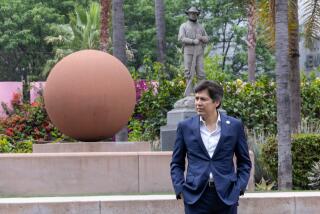Honoring ‘Ms. Chatsworth’
- Share via
Virginia Watson first traveled to Chatsworth as a teenager, making the drive with friends and family nearly 70 years ago from her home in Highland Park to a cabin in what was then a far-flung community of ranches and orange groves.
Sixty-eight years later, Watson is so closely identified with the community she adopted as her own that locals view her as its matriarch -- and head historian.
“She is Ms. Chatsworth,” said Andre van der Valk, a co-president of the Chatsworth Historical Society. “She represents Chatsworth, and if there’s anything going on in Chatsworth, past, present and future, she knows about it.”
On Sunday, Watson was honored by neighbors, members of the historical society she helped start, and city officials at the community’s Pioneer Day festival.
As cameras flashed, she turned around to view the unveiled sign renaming the Chatsworth Museum the Virginia Watson Chatsworth Museum, and she gasped in surprise.
“I don’t really know what to say. I’m kind of overwhelmed,” Watson said, tears welling in her eyes. “Thank you very much for thinking of me. . . . Nobody told me anything.”
She first became intrigued with Chatsworth’s history when after moving there in 1952 she read a column in the local newspaper mentioning her family as the first English-speaking settlers in Chatsworth in 1874.
A history buff and writer -- Watson later wrote a column called “Out Our Way” on Chatsworth for the Daily News -- she was hooked. She wanted to find out more.
“I started collecting things, anything about Chatsworth, and people still alive could remember [history], and I spoke with them. In the 1960s I started collecting pictures,” Watson said.
Chatsworth, she learned, initially was inhabited by the Fernandeo tribe that had a village near what is now the intersection of Canoga Avenue and Rinaldi Street.
In the late 1850s, a stagecoach route came through from Los Encinos State Historic Park, across the Valley, through the Santa Susana Pass and up the coast. Residents voted to become part of Los Angeles in 1913 in order to get water from the Owens River.
Still rural by the 1930s, Chatsworth was the setting for movies and, later, television shows, including “The Fighting Seabees” with John Wayne, and the TV series “Bonanza.”
Roy Rogers and Dale Evans had a ranch there, as did Lucille Ball and Desi Arnaz.
In the 1970s and ‘80s, as the area’s population grew, condominiums, mini malls and shopping centers began to replace many of the farms and groves.
“We have a long and colorful history,” said the 86-year-old Watson, who helped found the historical society in 1963.
Watson took her research seriously. She looked up statistics at the Census Bureau in Washington, D.C., and found details at the Huntington Library and Southwest Museum.
In the early 1960s she wrote a book, “Chatsworth History,” now published by the historical society and in its fourth edition.
“It’s been her whole life,” said Kelley Daily, 53, one of Watson’s two daughters, gesturing toward the museum grounds. “My dad used to say -- when he was alive -- she lived here.”
Today, Watson is the curator of the museum, a single room with a roughly 300-piece collection on display and hundreds of other items stored away.
The 1.3-acre homestead, which includes the museum, historical society and a restored home from the early 1900s, is on the National Register of Historic Places and is a Los Angeles Cultural Historical Monument, Watson said.
She is one of about half a dozen society members who were part of the founding committee.
The younger docents try to learn Watson’s large inventory of facts. “Only Virginia would know that,” they say.
“She’s got an unbelievable memory of everything she’s touched, where it’s stored, the people she’s talked to all along. She remembers all the stories,” said Ann Vincent, 55, a docent for the society’s museum.
That was evident Sunday as Watson, dressed in a pioneer-style, white frill-and-lace shirt buttoned up to her neckline and a long, flowing black skirt, spoke to museum-goers.
One man asked about the Ball and Arnaz ranch.
Watson’s eyes lit up as she thought back to the time in the early ‘50s when the couple moved in.
“Corbin and Devonshire,” she said, describing the streets where they lived. She closed her eyes.
“The southwest corner.”
A postman who delivered mail to the ranch often would get teased because he’d while away the time chatting with Ball, who Watson said was very friendly. Then, in the corner of the museum, she pointed out a photo of Ball at her home.
Outside, those at the festival enjoyed the fruits of Watson’s labor, learning about their community, touring the restored cottage, trying their hand at panning for gold, and walking through the gardens with small plaques honoring former members of the historical society.
“Some of these people never know that something will be named after them,” said Dan Huffman, a 10-year member of the historical society.
“This is her life,” Huffman said. “I don’t think a soul on this Earth [would dispute] that she is well deserving of this.”
More to Read
Sign up for Essential California
The most important California stories and recommendations in your inbox every morning.
You may occasionally receive promotional content from the Los Angeles Times.













